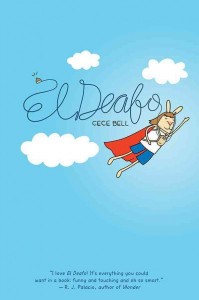El Deafo
 I was glad to see this one listed among so many of your favorites, as it is in mine. But how do we discuss this graphic novel for the Newbery? Let’s look at some of the language in the criteria.
I was glad to see this one listed among so many of your favorites, as it is in mine. But how do we discuss this graphic novel for the Newbery? Let’s look at some of the language in the criteria.
Definition #1: . “Contribution to American literature” indicates the text of a book. It also implies that the committee shall consider all forms of writing—fiction, non-fiction, and poetry. Reprints, compilations and abridgements are not eligible.
Okay, that is pretty clear cut. The award, which is “awarded annually to the author of the most distinguished contribution to American literature for children published by an American publisher in the United States in English during the preceding year”… is really awarded to the author of the most distinguished contribution in text for children. The definition goes on to say that “all forms of writing” should be considered. Considering this award was created in 1921 (and that in 1937 they had to create another one for picture books), I see an invitation to be in broad in our thinking of “literature” as possible. Just, er, the “text” part.
Farther down, in criterium number one we get (emphases all mine):
1. In identifying “distinguished contribution to American literature,” defined as text, in a book for children,
a. Committee members need to consider the following:
Interpretation of the theme or concept Presentation of information including accuracy, clarity, and organization Development of a plot Delineation of characters Delineation of a setting Appropriateness of style.Note: Because the literary qualities to be considered will vary depending on content, the committee need not expect to find excellence in each of the named elements. The book should, however, have distinguished qualities in all of the elements pertinent to it.
I see here that we are to argue El Deafo based on the merits of those bulleted points, as evidenced in the text. And, that the text only needs to show distinguished literary qualities in the the elements pertinent to this text. So, if setting is portrayed primarily through the images, does it need to stand out as distinguished in the text as well? I’d suggest not. Criterium 2:
2. Each book is to be considered as a contribution to American literature. The committee is to make its decision primarily on the text. Other components of a book, such as illustrations, overall design of the book, etc., may be considered when they make the book less effective.
Okay, we may consider the picture when they make the book less effective… but may not in any other case. That means that in every darned panel, we need to ferret out what it is the text is doing. I do not believe that these criteria tell us that the text must carry the entirety of the plot, characters, setting and style. Only that we must find those elements distinguished within the text…at least whichever elements are pertinent to the text. If, in a series of panels, the character development is solely communicated in the illustrations: fine. We won’t talk about character development there, because it is not pertinent to the text.
What part does the text play in developing the story? Is it distinguished in the part it plays?
That is my own interpretation of what these criteria ask us to do. The committee each year is charged with interpreting the criteria, so unless I was chair every year, there’s no way I can guarantee you that this is how the committee is looking at this. It’s just how I would. So, with that out of the way, let’s discuss El Deafo.
I’ll jump in, with the humor. Here is a favorite scene for many. While the illustrations heighten the humorous tension, I think it’s really carried in the words, as you can see here:
“Best–or worst–of all, I can even hear Mrs. Lufton when she USES THE BATHROOM.”
squeeeak
zzzzip
tinkle tinkle. “Oh no! Hee Hee!”
“Aaah…What a relief!” tinkle tinkle tinkle
WOPWOP “Toilet paper?”
“I know what’s coming!” zzzzzzip!
FLUSH!
Much of it is in the comic timing of text as laid out in panels, and is evidenced throughout the book. (Another favorite on mine is on page 61, when her prayers for a new friend are answered.)
Cece’s emotional arc of self-awareness, her coping mechanisms and challenges in navigating friendships, are all delivered in a voice that is as lively in the text as in any non-graphic novel this year. I think the voice outshines, for instance, that in RAIN REIGN, and matches that in NEST (neither of which we’ve really discussed, but feel free to jump in). The plot works as it needs to in a memoir, doing a fine job of taking us through the main story of the character development. All these things I think I can find evidence for the text. How about you?
RELATED
The job outlook in 2030: Librarians will be in demand
The job outlook in 2030: Librarians will be in demand
ALREADY A SUBSCRIBER? LOG IN
We are currently offering this content for free. Sign up now to activate your personal profile, where you can save articles for future viewing






Add Comment :-
Be the first reader to comment.
Comment Policy:
Comment should not be empty !!!